形容词和副词的用法总结
初中的归纳常见的形容词与副词的用法总结

初中的归纳常见的形容词与副词的用法总结形容词和副词在英语中扮演着非常重要的角色,它们可以描述事物的特征和状态,使我们的表达更加生动和具体。
在初中阶段,学生们需要掌握常见的形容词和副词的用法,以便更好地写作和表达自己的想法。
下面是一些常见的形容词和副词的用法总结。
一、形容词的用法1. 形容词的位置形容词通常位于名词之前,用来描述名词的特征或性质。
例如:- a beautiful flower(一朵美丽的花)- an interesting book(一本有趣的书)2. 形容词作表语形容词也可以作为表语,用来描述主语的特征或状态。
例如:- The weather is sunny today.(今天天气晴朗。
)- She seems tired.(她看起来很累。
)3. 形容词的比较级和最高级形容词可以根据程度的不同,用比较级和最高级来表示。
比较级用于两个事物的比较,最高级用于三个或三个以上事物的比较。
例如:- This book is more interesting than that one.(这本书比那本书更有趣。
)- English is the most widely spoken language in the world.(英语是世界上使用最广泛的语言。
)二、副词的用法1. 副词的位置副词通常位于动词之前,用来修饰动作的方式、程度或频率。
例如:- He runs fast.(他跑得快。
)- She speaks English fluently.(她流利地讲英语。
)2. 副词作状语副词可以作为状语,用来描述动词、形容词或其他副词的方式、程度或频率。
例如:- He sings loudly.(他大声唱歌。
)- The car is too expensive.(这辆车太贵了。
)3. 副词的比较级和最高级副词的比较级和最高级的形式和用法与形容词类似。
例如:- She runs faster than her brother.(她跑得比她哥哥快。
形容词副词用法总结

形容词副词用法总结(一)形容词的基本用法:形容词是用来描写或修饰名词或代词的一类词,在句中用作定语、表语、补语和状语。
1.作定语,就是放在名词前面的成分。
This is anewhouse. John is acleverboy.2.作表语,就是放在系动词后面的成分。
The boy is veryclever. He is verystrong.3.作补语,就是放在句子最后,起补充说明的成分。
The room is foundempty.(主语补足语)The news made herhappy.(宾语补足语)4.作其它成分,如状语,这个知识点比较难,以后的学习中做慢慢的介绍。
5.当几个形容词共同修饰同一名词时,它们的先后顺序是:限定词→数词→描述性形容词→大小、长短、形状的形容词→色彩形容词→类属形容词→表材料形容词+被修饰的名词;或只记住限定词像a, the, my, their等词在最前边,其它词根据它们与被修饰名词关系的远近进行安排。
6.一般来说,单个副词修饰形容词时,副词放在形容词前;但enough修饰形容词时要放在形容词之后。
good enough,tall enough7.形容词修饰名词时放在前边,但修饰复合不定代词(something,someone,somebody;anything,anyone,anybody;nothing,no one,nobody)时,则放在这些词之后somethingimportant,anythingpossible。
(二)副词的基本用法:副词是用以修饰动词、形容词、副词以及全句的词,表示时间、地点、方式、程度、疑问等概念。
1.作状语:The studentswatchhimquietly.(修饰动词)2.作表语:Time isup. Let’s go.(表示状态)3.作定语:Lifethereis very dull.(一般后置)4.修饰形容词或副词,表示程度:His invention isveryuseful.(修饰形容词)Henry singsquitewell.(修饰副词)5.副词作状语时,位置很灵活:Hewalks slowly.(动词后)Ioftenswim in summer.(动词前)Maybeyou are right.(句首)That’sall right.(形容词前)Tom speakstooquickly.(副词前)6.副词表示频度,修饰动词时位于系动词be和助动词后,行为动词do之前,还可置于句首或句末。
形容词和副词用法总结归纳讲解

C.especiallyD.luckily
12._____, the thief didn’t take anything valuable but my notebook.
A. Strange it isB. To be strange
C. Strangely enoughD. It was strange
C. surprisinglyD. hardly
4.—What do you think of the plan?
—I feel_____that we ought to give it up at once.
A. strongB. stronger
C. stronglyD. it strong
5.【1993全国】She doesn’t speak_____her friend, but her written work is excellent.
Watch hite意思是“晚”;lately意思是“最近”。如:
What have you been doing lately?
3.deep与deeply
deep意思是“深”,表示空间深度;deeply时常表示感情上的深度,“深深地”。如:
He pushed the stick deep into the mud.
8._____, he didn’t fail in the exam.(luck)
9.He was _____ ill and I was _____ sorry for that. (terrible)
10.It was _____ (extreme) cold that day and the meeting was _____ (especial) important.
小学英语语法形容词副词的用法总结整理归纳

小学英语语法形容词副词的用法总结整理归纳形容词是用来描述事物的特征和性质的词语,而副词则用来描述动作的方式、程度、时间等。
下面是小学英语形容词和副词的用法总结:形容词的用法:1. 形容词一般置于名词之前,用来修饰名词。
例如:a big house (一座大房子),a happy girl(一个快乐的女孩)。
2. 形容词可以用于比较级和最高级。
比较级用来比较两个事物的不同,最高级用来比较三个或以上事物的不同。
例如:This book is bigger than that one(这本书比那本大);He is the tallest boy in the class(他是班级里最高的男孩)。
3. 形容词可以和"be"动词连用,表示事物的状态或性质。
例如:She is beautiful(她很漂亮)。
副词的用法:1. 副词可以修饰动词,表示动作的方式、程度等。
例如:He runs quickly(他跑得很快)。
2. 副词可以修饰形容词,表示形容词程度的大小。
例如:She is very beautiful(她非常漂亮)。
3. 副词可以修饰其他副词,表示副词的程度。
例如:He reads quite slowly(他读得相当慢)。
4. 副词也可以修饰整个句子,表示说话人的态度或观点。
例如:Certainly, I will help you(当然,我会帮助你)。
需要注意的是,有一些形容词和副词的形式是相同的,需要根据具体情况来判断其词性。
同时,有些形容词和副词可以通过在词尾加上"-ly"来转化为副词形式。
英语形容词副词用法总结

英语形容词副词用法总结英语中的形容词和副词是两种重要的词性,它们在句子中起着描述和修饰的作用。
以下是它们的用法总结:一、形容词的主要用法:形容词修饰名词,说明事物或人的性质或特征。
例如:a beautiful girl(一个漂亮的女孩)。
形容词可以作表语,说明主语的状态、性质等。
例如:The sun is bright today.(今天的阳光很明媚。
)形容词可以作定语,修饰名词。
例如:a red apple(一个红苹果)。
多个形容词修饰名词时,其顺序为:限定词+数量词+描绘词+大小+形状+颜色+国籍+材料+名词。
例如:a small round table(一张小圆桌)。
二、副词的主要用法:副词修饰动词,说明动作的方式、程度等。
例如:He speaks loudly.(他说话很大声。
)副词可以修饰形容词或其他副词,说明它们的程度。
例如:This problem is extremely difficult.(这个问题非常困难。
)副词可以作表语,说明主语的状态。
例如:The light is on.(灯开着。
)副词可以分为时间副词、地点副词、方式副词等。
例如:He often goes to the park.(他经常去公园。
)在这个句子中,“often”是时间副词。
多个副词修饰动词时,其顺序通常为:方式副词+地点副词+时间副词。
例如:He quietly entered the room yesterday.(他昨天悄悄地进入了房间。
)请注意,形容词和副词在句子中的具体用法可能会因语境而异。
为了更准确地使用它们,建议多阅读英语文章和例句,以增强语感。
(完整版)副词与形容词的用法

副词和形容词一、形容词的用法1.形容词修饰名词,并且放在名词的前面,这时形容词在句子中作定语例如: a beautiful lady、a tall man、a big houseA beautiful lady is standing in front of a tall man.2.形容词放在be动词的后面,这时形容词在句子中作表语/主语补足语。
例如:The lady is tall. (tall在句子中作表语,说明lady是怎么样的)The beautiful lady is tall. (beautiful在句子中作定语,tall作表语)The beautiful lady is tall and slim.3.形容词放在连系动词(become成为、seem看起来、taste尝起来、look看起来、smell闻起来、feel摸起来/感觉、turn变成,等等)后面,在句子中作表语/主语补足语。
例如:The leaf (叶子) turned yellow.树叶变黄了。
She looks beautiful./ He looks handsome. 她看起来漂亮。
/他看来帅气。
The food taste good. 这些食物好吃。
The sweater feels soft. (柔软的;舒服的)He becomes careful. (小心的) 他变得小心了。
The flower smells very good. 花闻起来很香。
Everything seems good. 一切看起来都好。
二、副词的用法1.副词修饰动词,并且通常放在实义动词后面,这是副词在句子中作方式状语。
例如:The man runs fast. (fast修饰runs这个动作)She jumps high. (high修饰jump这个动作)He finished his homework quickly. (quickly修饰finished这个动作)2.副词修饰形容词,并且通常放在形容词的前面例如:He becomes very handsome.She looks very beautiful.The lady is very tall and slim.在“副词+形容词”这样的结构中,中心词是形容词,副词只是为了说明程度大小即:very handsome的中心词是handsome3.副词前面也可以加副词,例如上面的句子都可以改写成:The man runs very fast.She jumps very high.He finished his homework very quickly.very本身是副词,意思是“非常,很”,所以后面也可以跟副词或者形容词。
形容词和副词的用法

形容词和副词的用法作用:1.形容词:(1)形容词在句中常修饰名词和代词。
A good boy. Somethi ng important(2)形容词在句中作定语、表语、宾语补足语。
Our country is a beautiful co untry.(作定语)The meal is delicious. (作表语)We keep our classroom clean and tidy.(作宾语补足语)2.副词:(1)副词在句中修饰动词、副词、形容词、全句(Luckily)。
She speaks En glish w也(2)副词在句中可作状语、表语、和定语。
He studies very hard. (作状语)When will you be back. (作表语)Luckily, I passed the exam.常用来修饰原级的词有:very , too, so, really, quite, pretty、位置1.形容词:通常要放在所修饰的名词之前,但要放在不定代词(之后。
something、anything …)2.副词:1 )多数副词作状语时放在行为动词之后。
如果动词带宾语,则放在宾语之后。
Mr. Smith works very hard._ She speaks En glishweJl.2)频度副词作状语时,通常放在行为动词之前,情态动词、be动词和助动词之后。
He usually gets up early.3)程度副词一般放在所修饰的名词前面。
I am n ever late for school.He runs very fast.形容词和副词的比较级和最高级。
大多数形容词和副词有三个等级:原级、比较级、最高级。
原级指形容词和副词的原形;比较级用来表示较……”或更……一些”;最高级则表示最……”、形容词和副词的原级:1.表示两者(A与B)在某一方面相同时用句型:A +谓语+ as +形容词或副词的原形+ as+ B.。
形容词和副词的用法

形容词和副词的用法 It was last revised on January 2, 2021形容词和副词的用法作用:1.形容词:(1)形容词在句中常修饰名词和代词。
A good boy. Something important(2)形容词在句中作定语、表语、宾语补足语。
Our country is a beautiful country. (作定语)The meal is delicious. (作表语)We keep our classroom clean and tidy. (作宾语补足语)2.副词:(1)副词在句中修饰动词、副词、形容词、全句(Luckily)。
She speaks English well. Luckily, I passed the exam.(2)副词在句中可作状语、表语、和定语。
He studies very hard. (作状语) When will you be back.(作表语)注意:常用来修饰原级的词有:very,too, so, really, quite, pretty等一、位置1.形容词:通常要放在所修饰的名词之前,但要放在不定代词(something、anything…)之后。
2.副词:1)多数副词作状语时放在行为动词之后。
如果动词带宾语,则放在宾语之后。
Mr. Smith works very hard. She speaks English well.2) 频度副词作状语时,通常放在行为动词之前,情态动词、be动词和助动词之后。
He usually gets up early. I am never late for school.3) 程度副词一般放在所修饰的名词前面。
He runs very fast.形容词和副词的比较级和最高级。
大多数形容词和副词有三个等级:原级、比较级、最高级。
原级指形容词和副词的原形;比较级用来表示“较……”或“更……一些”;最高级则表示“最……”一、形容词和副词的原级:1.表示两者(A与B)在某一方面相同时用句型:A + 谓语 + as + 形容词或副词的原形 + as+ B.eg: ① Tom 和 Sam 一样高。
形容词副词用法总结
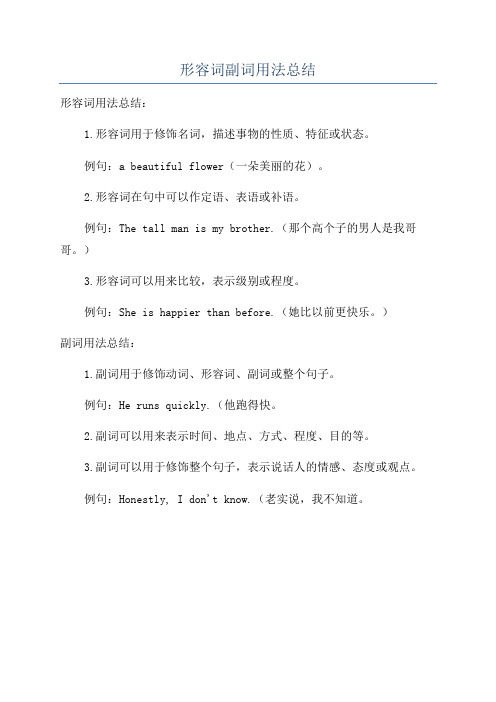
形容词副词用法总结
形容词用法总结:
1.形容词用于修饰名词,描述事物的性质、特征或状态。
例句:a beautiful flower(一朵美丽的花)。
2.形容词在句中可以作定语、表语或补语。
例句:The tall man is my brother.(那个高个子的男人是我哥哥。
)
3.形容词可以用来比较,表示级别或程度。
例句:She is happier than before.(她比以前更快乐。
)
副词用法总结:
1.副词用于修饰动词、形容词、副词或整个句子。
例句:He runs quickly.(他跑得快。
2.副词可以用来表示时间、地点、方式、程度、目的等。
3.副词可以用于修饰整个句子,表示说话人的情感、态度或观点。
例句:Honestly, I don't know.(老实说,我不知道。
高中英语形容词和副词的用法汇总

高中英语形容词和副词的用法汇总形容词和副词一、形容词1. 形容词的位置形容词作定语通常放在它所修饰的名词前面,但在下列情况下,形容词可以或必须后置:1)形容词作定语修饰由some, any, every, no和body, thing, one等构成的复合不定代词时须后置。
如:We shall do everything necessary to bring the murderer to justice.Is there anyone new coming to tonight's meeting?2)以-ible和-able结尾的形容词可置于形容词最高级或only等所修饰的名词之后。
如:He is doing the best job possible.This was the only room available.3)一些表语形容词可置于所修饰的名词之后。
如:These facts alone show that he's not to be trusted.4)形容词短语一般须后置,往往相当于定语从句。
如:He was a king anxious for his people's welfare.2. 前置形容词的排列顺序多个形容词修饰名词时,它们的顺序大致为:描绘性形容词(短词在前,长词在后)→表特征的形容词(包括大小、形状、新旧、年龄等,顺序也大致如此,但不固定)→表颜色的形容词→表类属的形容词(包括专有形容词和表材料质地的形容词)。
如:the beautiful little white Chinese bridgea tall intelligent young British officer二、副词1. 副词的分类副词大体上可分为下面几类:1)时间副词,如before, early, now。
2)地点副词,如everywhere, there, here。
形容词副词的用法归纳总结

形容词副词的用法归纳总结形容词和副词是英语中非常重要的词性,它们在句子中起到修饰和描述的作用。
以下是形容词和副词的用法归纳总结:一、形容词的用法1. 作定语:形容词通常用于修饰名词或代词,位于所修饰的名词或代词之前。
例如:a beautiful flower,the smart boy。
2. 作表语:形容词可以用于系动词之后,构成“主系表”结构,描述主语的特征或状态。
例如:She is beautiful. The food tastes good.3. 作宾语补足语:形容词可以用于某些动词的宾语之后,补充说明宾语的特征或状态。
例如:We made the room clean. Please keep the door open.4. 比较级和最高级:形容词可以通过比较级和最高级的形式来进行比较。
比较级用于两者之间的比较,最高级用于三者或以上的比较。
例如:bigger,the biggest。
二、副词的用法1. 修饰动词:副词通常用于修饰动词,描述动作的方式、程度、时间等。
例如:She sings beautifully. He runs fast.2. 修饰形容词:副词也可以用于修饰形容词,增强形容词的描述效果。
例如:very beautiful,extremely smart。
3. 修饰其他副词:副词还可以用于修饰其他副词,进一步说明其程度或方式。
例如:He speaks very loudly.4. 时间和地点副词:副词可以表示时间和地点,如:now,yesterday,here,there。
5. 疑问副词和连接副词:疑问副词用于疑问句中,如:when,where,how;连接副词用于连接句子或从句,如:therefore,however。
需要注意的是,形容词和副词的用法比较灵活,具体使用要根据句子的结构和上下文来决定。
同时,也要注意形容词和副词的比较级和最高级的构成规则以及使用方法。
希望这些总结对你有所帮助。
英语形容词和副词用法

英语形容词和副词用法在英语中,形容词和副词是用来描述和修饰名词、代词或者动词的词性。
它们在句子中起到了非常重要的作用,能够让句子更加生动丰富。
本文将介绍英语形容词和副词的用法,并提供一些常用的例句。
一、形容词的用法形容词用来描述和修饰名词,可以加在名词前面或者后面。
下面是一些常见的形容词用法:1. 形容词在名词前面的用法:- My cute dog loves to play in the park.(我的可爱的狗喜欢在公园里玩。
)- She has a beautiful dress for the party.(她有一件漂亮的派对裙子。
)2. 形容词在系动词后面的用法:- The weather is sunny today.(今天的天气晴朗。
)- The book seems interesting.(这本书看起来很有趣。
)3. 形容词在代词后面的用法:- I like this red one.(我喜欢这个红色的。
)- They prefer those big ones.(他们更喜欢那些大的。
)二、副词的用法副词用来修饰动词、形容词或者其他副词,能够更具体地描述行为或状态。
下面是一些常见的副词用法:1. 副词修饰动词:- She sings beautifully.(她唱得很优美。
)- He runs fast.(他跑得很快。
)2. 副词修饰形容词:- The movie is extremely exciting.(这部电影非常刺激。
)- The food smells deliciously.(这食物闻起来很好吃。
)3. 副词修饰其他副词:- He speaks English fluently.(他流利地说英语。
)- She danced gracefully.(她优雅地跳舞。
)三、形容词和副词的比较级和最高级形容词和副词可以用比较级和最高级来表达更高或更低的程度。
比较级用来将两个人或物进行比较,最高级则表示三个或三个以上人或物之间的比较。
初中英语知识点归纳形容词和副词的用法区别总结

初中英语知识点归纳形容词和副词的用法区别总结形容词和副词是英语语法中的两个重要部分。
它们在句子中具有不同的作用和用法。
下面是对初中英语知识点中形容词和副词用法区别的总结。
一、形容词的用法1. 形容词可以修饰名词,并在句中作定语,用于描述名词的性质、特征或状态。
例句:a beautiful girl(一个美丽的女孩)2. 形容词可以充当表语,与系动词be连用,用于描述主语的性质或状态。
例句:She is intelligent.(她很聪明。
)3. 形容词可以在句中作宾语补足语,用于补充说明及描述宾语。
例句:I found the movie interesting.(我觉得这部电影有趣。
)4. 形容词可以用来表示数量或顺序的范围。
例句:He has only three books.(他只有三本书。
)二、副词的用法1. 副词可以修饰动词,用于描述动作的方式、频率、程度等。
例句:She runs quickly.(她跑得很快。
)2. 副词可以修饰形容词,用于描述形容词所修饰的程度。
例句:He is very tall.(他非常高。
)3. 副词可以修饰其他副词,用于描述副词之间的程度关系。
例句:He speaks English quite fluently.(他英语说得相当流利。
)4. 副词可以在句中作状语,表示时间、地点、原因、方式、条件等。
例句:We will go to the park tomorrow.(我们明天去公园。
)三、形容词和副词的区别1. 作用对象不同- 形容词主要用于修饰名词,描述名词的性质、特征或状态。
- 副词主要用于修饰动词、形容词、其他副词,表示动作的方式、程度、频率等。
2. 词性不同- 形容词是描述性词,属于形容词类。
- 副词是修饰性词,属于副词类。
3. 位置不同- 形容词通常位于名词之前,修饰名词。
- 副词可以位于动词、形容词、副词等之前或之后,修饰这些词。
4. 用法不同- 形容词在句中可以作定语、表语、宾语补足语等。
(完整版)形容词与副词的用法
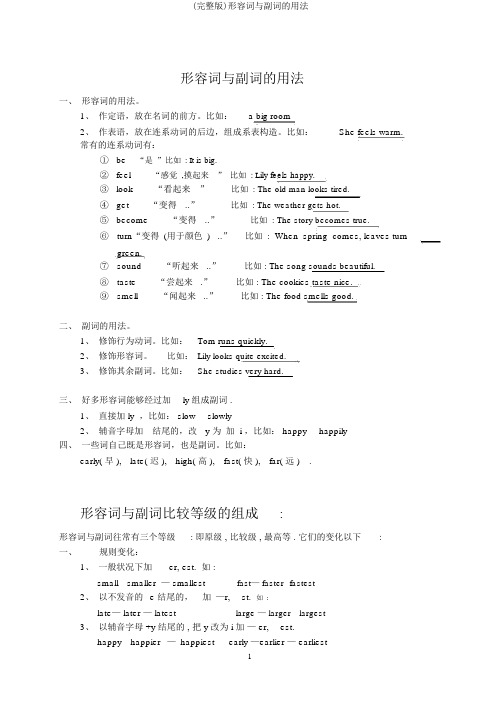
形容词与副词的用法一、形容词的用法。
1、作定语,放在名词的前方。
比如: a big room2、作表语,放在连系动词的后边,组成系表构造。
比如:She feels warm.常有的连系动词有:①be“是”比如: It is big.②feel“感觉,摸起来” 比如: Lily feels happy.③look“看起来”比如: The old man looks tired.④get“变得..”比如: The weather gets hot.⑤become“变得..”比如: The story becomes true.⑥turn“变得(用于颜色) ..” 比如: When spring comes, leaves turngreen.⑦sound “听起来 ..”比如 : The song sounds beautiful.⑧taste “尝起来 .”比如 : The cookies taste nice.⑨smell “闻起来 ..”比如 : The food smells good.二、副词的用法。
1、修饰行为动词。
比如:Tom runs quickly.2、修饰形容词。
比如:Lily looks quite excited.3、修饰其余副词。
比如:She studies very hard.三、好多形容词能够经过加ly 组成副词 .1、直接加 ly ,比如: slow----slowly2、辅音字母加结尾的,改y 为加 i ,比如: happy----happily四、一些词自己既是形容词,也是副词。
比如:early( 早 ), late( 迟 ), high( 高 ), fast( 快 ), far( 远 ).形容词与副词比较等级的组成:形容词与副词往常有三个等级: 即原级 , 比较级 , 最高等 . 它们的变化以下:一、规则变化:1、一般状况下加 ----er, est. 如 :small---smaller — smallest fast— faster--fastest2、以不发音的 e 结尾的,加—r, ---st.如:late— later — latest large — larger---largest3、以辅音字母 +y 结尾的 , 把 y 改为 i 加— er, ---est.happy---happier—happiest early —earlier — earliest14、以重读闭音节结尾且末端只有一个辅音字母的,双写末端辅音字母再加—er,--est.big — bigger — biggest hot — hotter —hottest fat —fatter — fattestthin — thinner —thinnest5、部分双音节和所有多音节形容词与副词在前方加more, most.形容词加 ly 组成的副词也是在前方加more,most.careful---more careful---most carefulwidely---more widely---most widelyquickly---more quickly—most quicklypopular — more popular---most popular二、不规则变化:原级比较级最高等good, well 好的better bestbad, badly, ill 坏的,糟糕worse worst的,差的many, much 多more mostlittle 少less leastfar 远farther farthest形容词与副词比较等级的用法:1、非常较对象时,用原级。
英语形容词和副词的用法总结

英语形容词和副词的用法总结
形容词和副词是英语中非常重要的词汇,它们可以用来描述名词、代词或句子的状态或程度。
下面是对形容词和副词用法的总结:
形容词的用法:
1. 描述名词:形容词用于描述名词的特征或属性,例如“美丽的花朵”、“高大的建筑物”。
2. 修饰名词:形容词可以用来修饰名词,使其更具体或更明确,例如“小汽车”、“美丽的花园”。
3. 强调比较级:在描述两个人或两个事物之间的差异时,可以使用形容词的比较级来强调其中一个的特点,例如“她比他更高”。
副词的用法:
1. 描述动词:副词用于描述动词的行为、动作或状态的方式或程度,例如“他快速地跑”、“她非常开心”。
2. 修饰动词:副词可以用来修饰动词,使其更具体或更明确,例如“他慢慢地走来”、“她突然地跳起来”。
3. 强调比较级:在描述两个人或两个事物之间的差异时,可以使用副词的比较级来强调其中一个的特点,例如“他跑得比她快”。
4. 修饰形容词和副词:副词还可以用来修饰形容词或副词,使其更具体或更明确,例如“非常漂亮的衣服”、“非常快速地跑”。
需要注意的是,形容词和副词的用法有时会有一些重叠,但它们的主要区别在于形容词主要修饰名词,而副词主要修饰动词。
同时,形容词通常放在名词之前,而副词则放在动词、形容词或整个句子之前。
形容词副词用法总结
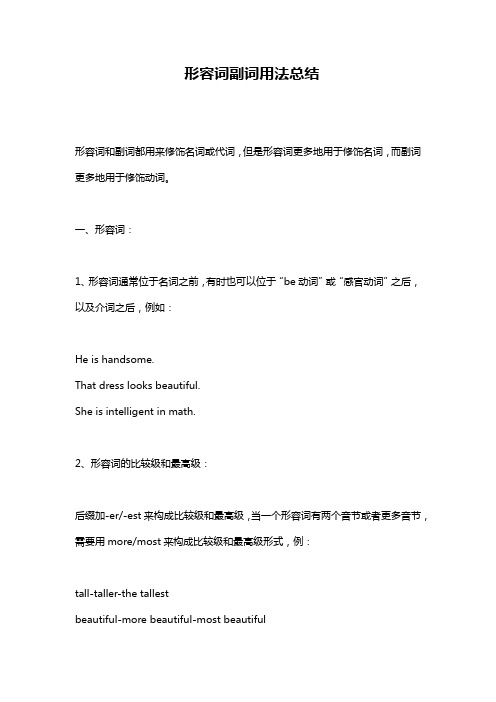
形容词副词用法总结形容词和副词都用来修饰名词或代词,但是形容词更多地用于修饰名词,而副词更多地用于修饰动词。
一、形容词:1、形容词通常位于名词之前,有时也可以位于“be动词”或“感官动词”之后,以及介词之后,例如:He is handsome.That dress looks beautiful.She is intelligent in math.2、形容词的比较级和最高级:后缀加-er/-est来构成比较级和最高级,当一个形容词有两个音节或者更多音节,需要用more/most来构成比较级和最高级形式,例:tall-taller-the tallestbeautiful-more beautiful-most beautiful3、形容词的反义词:具有反义关系的形容词可以直接用前缀un-来表示反义,例:happy-(un)-happy4、形容词的最高级的格式:形容词最高级的表达形式是“the +原级+ of/in +名词”,当名词前面提到的只有2个,可以不用of,例如:He is the tallest boy of the three.She is the prettiest girl in the class.二、副词:1、副词通常用来修饰整句,最常见的形式有“副词+动词”,例:She speaks quickly.2、副词的比较级和最高级:副词比较级和最高级一般通过-er和-est来构成,但也有些特殊情况,例如“good-better-best”;当副词有三个或者更多音节时,需要用more/most来构成比较级和最高级形式,例:carefully-more carefully-most carefully3、副词的最高级的格式:副词最高级的表达形式一般是“the +副词+ of/in +名词”,当名词前面提到的只有2个,可以不用of,例如:He runs the fastest of all.She dances the most beautifully in the party.。
形容词与副词的用法总结修饰名词与动词的不同方式

形容词与副词的用法总结修饰名词与动词的不同方式在英语语法中,形容词和副词是常用的词性,用于修饰名词和动词。
它们的使用方式有一些不同,下面将对形容词和副词在修饰名词和动词方面的用法进行总结。
一、形容词(Adjective)形容词用于修饰名词,可以表示名词的特征、状态、性质等。
常常出现在名词的前面或后面,用以描述或限定名词,从而让读者更准确地理解名词所代表的事物。
1. 形容词修饰名词时,通常放在名词的前面,如:a beautiful flower (一朵美丽的花),a tall building(一座高耸的大楼)。
2. 有些形容词可以放在名词的后面,如:the room clean(干净的房间),a man honest(一个诚实的人)。
这种情况通常是指那些在修饰特定的名词时,形容词只能放在名词的后面。
二、副词(Adverb)副词用于修饰动词、形容词、其他副词等,可以表示动作的方式、程度、频率等。
副词的作用是进一步描述或限定动词的动作,使其更具体、更生动。
1. 副词修饰动词时,通常放在动词的后面,如:She runs quickly(她跑得快),He speaks fluently(他说得流利)。
2. 副词修饰形容词时,通常放在形容词的前面,如:a highly intelligent student(一个非常聪明的学生),an extremely beautiful sunset(一场极其美丽的日落)。
3. 副词修饰其他副词时,通常放在被修饰的副词的前面,如:She walks very slowly(她走得很慢),He speaks quite softly(他说得相当轻声)。
需要注意的是,有些形容词和副词形式相同,只有在句子中的位置不同。
这就需要根据具体上下文来判断其作用。
总结起来,形容词主要用于修饰名词,而副词主要用于修饰动词、形容词、其他副词。
在使用上,形容词通常放在名词前面,而副词通常放在被修饰词的后面,这样可以更准确地表达出名词和动词的特征、状态、性质、方式、程度等。
形容词副词用法总结
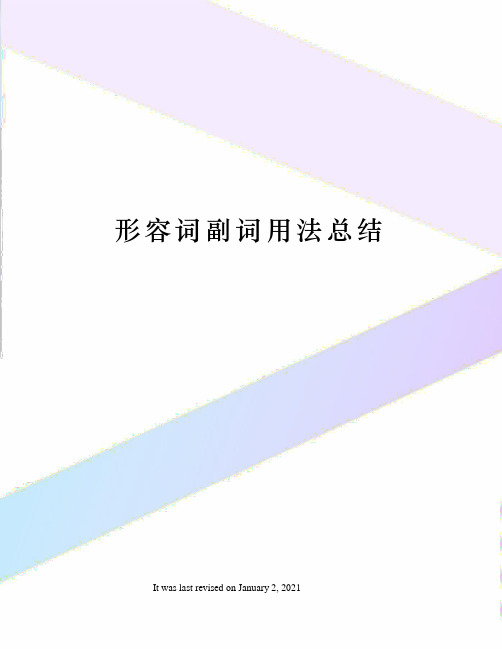
形容词副词用法总结 It was last revised on January 2, 2021形容词副词用法总结(一)形容词的基本用法:形容词是用来描写或修饰名词或代词的一类词,在句中用作定语、表语、补语和状语。
1. 作定语,就是放在名词前面的成分。
This is a new house. John is a clever boy.2. 作表语,就是放在系动词后面的成分。
The boy is very clever. He is very strong.3. 作补语,就是放在句子最后,起补充说明的成分。
The room is found empty.(主语补足语)The news made her happy.(宾语补足语)4. 作其它成分,如状语,这个知识点比较难,以后的学习中做慢慢的介绍。
5.当几个形容词共同修饰同一名词时,它们的先后顺序是:限定词→数词→描述性形容词→大小、长短、形状的形容词→色彩形容词→类属形容词→表材料形容词+被修饰的名词;或只记住限定词像a, the, my, their等词在最前边,其它词根据它们与被修饰名词关系的远近进行安排。
6. 一般来说,单个副词修饰形容词时,副词放在形容词前;但enough修饰形容词时要放在形容词之后。
good enough,tall enough7. 形容词修饰名词时放在前边,但修饰复合不定代词(something,someone,somebody;anything,anyone,anybody;nothing,no one,nobody)时,则放在这些词之后 something important,anything possible。
(二)副词的基本用法:副词是用以修饰动词、形容词、副词以及全句的词,表示时间、地点、方式、程度、疑问等概念。
1. 作状语:The students watch him quietly. (修饰动词)2. 作表语:Time is up. Let’s go. (表示状态)3. 作定语:Life there is very dull. (一般后置)4. 修饰形容词或副词,表示程度:His invention is very useful. (修饰形容词)Henry sings quite well. (修饰副词)5. 副词作状语时,位置很灵活:He walks slowly. (动词后)I often swim in summer.(动词前)Maybe you are right. (句首)That’s all right. (形容词前)Tom speaks too quickly.(副词前)6. 副词表示频度,修饰动词时位于系动词be和助动词后,行为动词do之前,还可置于句首或句末。
语法要点形容词和副词
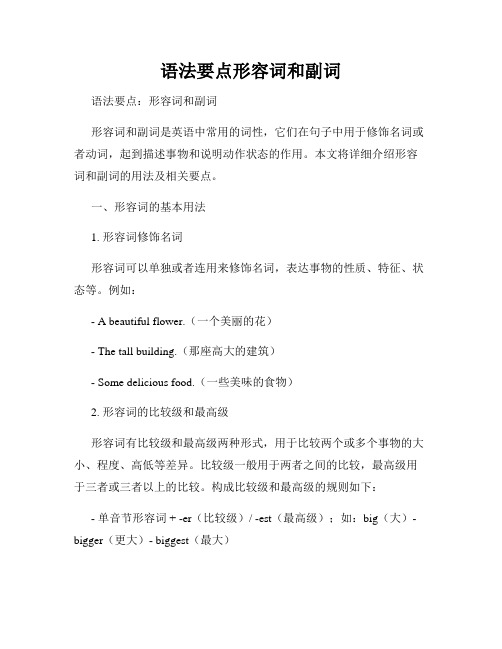
语法要点形容词和副词语法要点:形容词和副词形容词和副词是英语中常用的词性,它们在句子中用于修饰名词或者动词,起到描述事物和说明动作状态的作用。
本文将详细介绍形容词和副词的用法及相关要点。
一、形容词的基本用法1. 形容词修饰名词形容词可以单独或者连用来修饰名词,表达事物的性质、特征、状态等。
例如:- A beautiful flower.(一个美丽的花)- The tall building.(那座高大的建筑)- Some delicious food.(一些美味的食物)2. 形容词的比较级和最高级形容词有比较级和最高级两种形式,用于比较两个或多个事物的大小、程度、高低等差异。
比较级一般用于两者之间的比较,最高级用于三者或三者以上的比较。
构成比较级和最高级的规则如下:- 单音节形容词 + -er(比较级)/ -est(最高级);如:big(大)- bigger(更大)- biggest(最大)- 以“e”结尾的形容词 + -r(比较级)/ -st(最高级);如:large(大)- larger(更大)- largest(最大)- 以辅音字母+y结尾的形容词,去y变i + -er(比较级)/ -est(最高级);如:happy(开心的)- happier(更开心的)- happiest(最开心的)- 重读闭音节形容词,且末尾只有一个辅音字母,双写该辅音字母+ -er(比较级)/ -est(最高级);如:big(大)- bigger(更大)- biggest(最大)3. 形容词的位置形容词一般位于名词之前,有时也可位于系动词之后作表语。
例如:- She is a beautiful girl.(她是一个美丽的女孩)- The book is interesting.(这本书很有趣)二、副词的基本用法1. 副词修饰动词副词用来修饰动词,表示动作的方式、频率、时间等。
例如:- He speaks English fluently.(他流利地讲英语)- We often go to the park on weekends.(我们经常在周末去公园)2. 副词修饰形容词或者副词副词可以用来修饰形容词或者副词,表示程度、方式等。
- 1、下载文档前请自行甄别文档内容的完整性,平台不提供额外的编辑、内容补充、找答案等附加服务。
- 2、"仅部分预览"的文档,不可在线预览部分如存在完整性等问题,可反馈申请退款(可完整预览的文档不适用该条件!)。
- 3、如文档侵犯您的权益,请联系客服反馈,我们会尽快为您处理(人工客服工作时间:9:00-18:30)。
形容词和副词的用法形容词和副词都是起修饰作用的词,形容词修饰名词和代词。
副词修饰动词,形容词和其他副词或整个句子。
一形容词的构成1 本身是形容词。
如:good,happy 等。
2 由名词加y 构成:sun—sunny,wind —-windy,rain ——rainy,flower —-flowery.3.由名词+-able,+-ent,+-en,+-al,+-less,+-ful,+-ing,+-ive, 等构成,如:comfort —comfortable ,differ—different,nation —national, wood —wooden, care —- careful,care —careless, excite —-exciting, act —-active.4.由名词+ly 构成形容词,如:friendly ,lonely, lovely ,lively,likely,ugly,brotherly,motherly,fatherly,daily,weekly,monthly,yearly,early,manly,orderly,deadly, 等。
5 复合形容词如:kind-hearted,warm-hearted,well-educated,good-looking,man-made,Harding-working,peace-loving,new-born, snow-white,duty-free.二形容词的作用1 做定语修饰名词和代词 a good boy,something new, 等。
2 做表语,He is happy.3 作宾语补足语I found him hard-working.4 作主语补足语He was found hard-working.(被动语态中)5 做主语或宾语(前面加the )The new replaces the old. 新事物代替旧事物。
6 伴随状语Tired and hot, we have to stop to have a rest.三形容词的位置1 放在所修饰的名词前,a red coat.2 放在不定代词的后面something important.3 长宽高深等形容词放在数词+名词的后面,如:five meters high/deep/wide/long, six years old,4 enough 放在形容词和副词之后,名词前后均可。
big enough,enough time.5 一些以a-开头的表语形容词不能放在名词前面做定语,要放在名词后做后置定语,如:a man alive活着的人,a awake baby一个醒着的婴儿,a asleep baby —个睡着的婴儿,但是如果这些词本身带有副词修饰时,可以放在名词前面,如 a fast asleep baby 一个熟睡的婴儿the wide awake soldier十分清醒的士兵。
6 在下列结构中,形容词要放在冠词前,so/how/as/too+adj.+a/an+n.It is as pleasant a day as yesterday. How beautiful a park it isIt is too cold a day to go out. He is so clever a boy that heworks out the problem. 只做表语的形容词:ill,sorry,well,pleased,unable,sure,glad.几组常见形容词的区别1much too,too much 2 hard,hardly 3 too,also,either,as well4 already,yet 5 loud,loudly,aloud6 some time,sometime,some times,sometimes7ago,before 8 just,just now,now9 so such10 too enough副词一副词的分类1 时间副词放在句末,,2 地点副词放句末,地点副词与动词连用时,不加介词,go there,come here,Turn left,turn right=turn to the right,go east ,go west,go upstairs,go downstairs, go abroad,go somewhere/anywhere/everywhere, .....3 程度副词放在所修饰的词前面,enough 除外4频度副词放在be,第一个助动词,情态动词的之后,行为动词之前。
5 关系副词连接定语从句when,where,why6 疑问副词构成特殊疑问句when,where,why,how ....7 连接副词连接名词性从句(宾语从句,表语从句,主语从句等when ,where,why,how ...注意? ?方式状语,地点状语,时间状语,按这个顺序二副词的构成1 本身是副词very ,rather 等。
2 与形容词形式一样hard,early, late, high,wide ,deep 等。
an early bus,get up early the late changes,stay up late,200meters high,fly high ,50 feet deep,on a hard floor,study hardtalk deep into the night 谈到深夜,ten minutes late 晚十分钟,arrive late, a wide street,open your mouth/eyes wide,be widely used.3 由形容词+ly 构成,slow-slowly,quick-quickly,brave-,bravely,clear-clearly.4部分以-e结尾的形容词,去e+ly,构成副词。
true-truly , possible-possibly,terrible-terribly,simple-simply,probable-probably. widely5以辅音字母+y结尾的单词,变副词要把y改成i再加ly,如:happy-happily。
6本身是副词,加上ly以后意义不同。
late lately ,hard hardly,close closely,like likely,deep deeply,high highly,wide widely, goog ——well三副词的作用1作状语修饰动词rain heavily ,修饰形容词原形的词too,rather ,very,so quite ,修饰其他副词too fast,修饰介词just behind the door,修饰从句This is exactly what I need修饰其他词almost every one,n early 100 people 等。
2 做后置定语the girl there,the population here.3 作表语,Who is in?4 作补语Let him out.5 作介宾from abroad/here几组常见副词的用法区别1much too,too much 2 hard hardly 3 too ,also either, as well 4 already ,yet 5loud,loudly6 some times ,sometimes,sometime,some time 7 too ,enough 8 ago before 9just,just now ,now10 so, such形容词和副词的比较级最高级形式二) 比较级句型1比较级+tha n +比较对象No(other)+单数名词/no oneany other +单数名词(all) the other + 复数名词anyone else/a nything else=nob fh n ot fi e++比较级词than 没有比…更…一比较级的构成规则1规则变化2不规则变化二比较级的用法)原级比较句型肯定句型A....+as+adj,/adv.+as+B和...... 一样否定句型 A ..... +not+so/as+adj./adv. +as+B. A不如 B降级比较 A …+less+adj./adv.+than B .A不如 BNo other way is better than this one.No ( other)+单数名词/no one/nobody/none ... +as/so+adj./adv.+as+No ocea n in the world is as big as the Pacific Ocea n.2 the+比较级…,the+比较级…越…,越…。
3比较级+and+比较级,越来越…。
4 the+比较级+of the two.....,两者中较为…的一个。
5疑问词+be+t匕较级,A or B?两者中最 ... ?能够修饰比较级的单词much,far,even,still,any, rather ,a lot, a little,a bit,a great deal,三)最高级句型1 .... t he+最高级+可数名词单数+of/in/among , 中最 ..........2 .... o ne of the+最高级+ 复数名词+of/in/among , .. 最... 之一。
3特殊疑问词+ be+the + 最高级,A, B or C三者中最..... ?特殊疑问词+行为动词+副词最高级,A , B or C?Who runs fastest,Jim,Kate or Mike 4 the+序数词+最高级+单数可数名词+in (范围)在.....第几最.....能修饰最高级的词by far,almost,nearly ......比较级注意事项1 比较对象必须是对等的即同类事物或人.It is colder in Beijing than in Shanghai.2句中后面的名词避免重复,使用that代替可数名词单数或不可数名词,用those 代替可数名词复数,也可以用the one 代替单数可数名词。
The weather in Beijing is colder than that in Shanghai.The students in our class are stronger than those in their class.The girl in red is taller than the one in green .3 比较对象在同一范围内时用other 把自身排除掉,不在同一范围内不用otherShanghai is bigger than any other city in China.Shanghai is bigger than any city in Africa.4 no +比较级+than两者均否定,译为“一样不”…not +比较级+than,两者均肯定,前者不如后者,译为“…不如…”This problem is no more important than that one. 这个问题和那个问题一样不重要。
